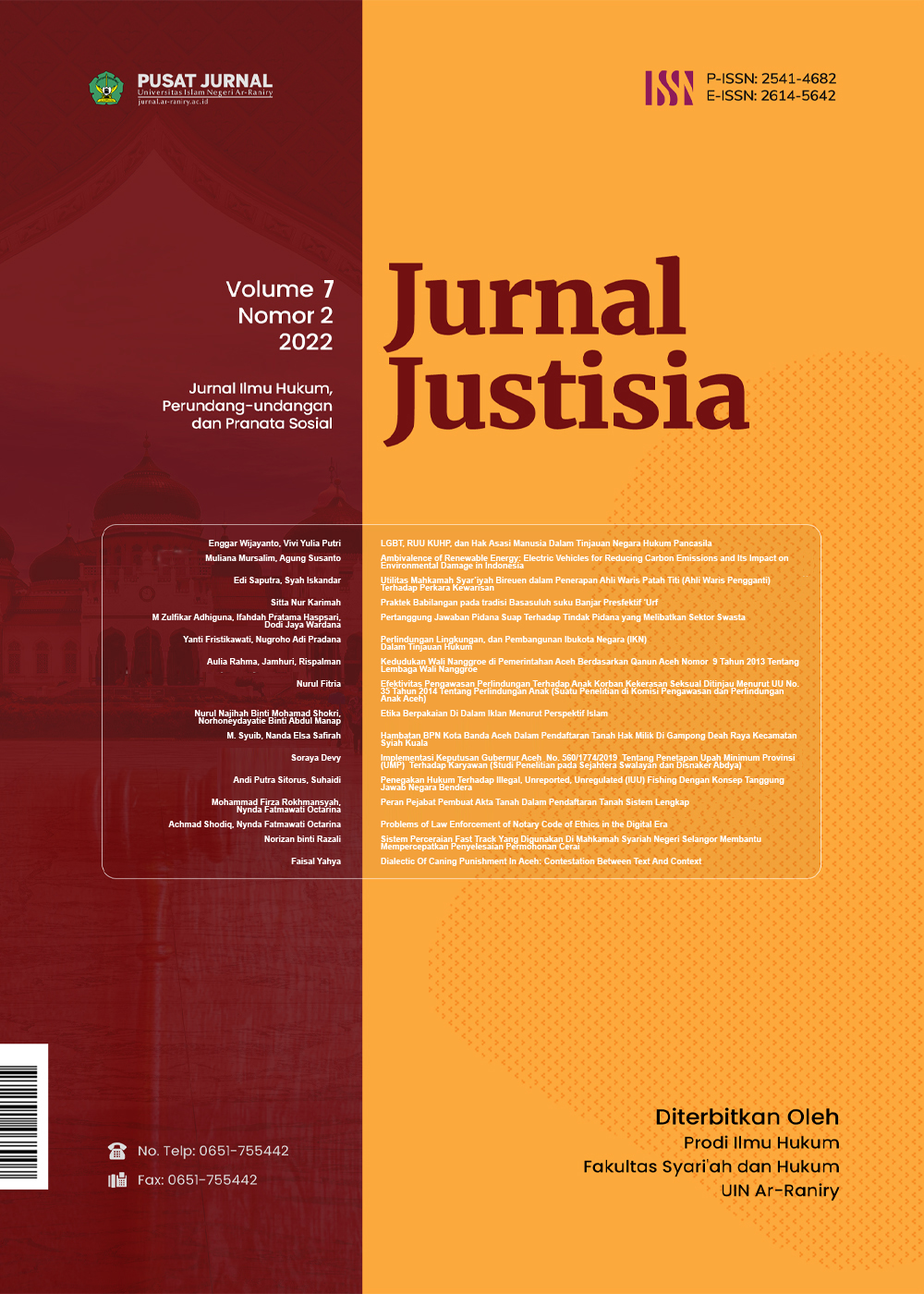Ambivalensi Energi Terbarukan : Kendaraan Listrik Untuk Penurunan Emisi Karbon dan Dampaknya Terhadap Kerusakan Lingkungan di Indonesia
DOI:
https://doi.org/10.22373/justisia.v7i2.15047Abstract
This article discusses the phenomenon of electric vehicles which are an alternative to reducing carbon emissions. This study discusses the intervention between the implementation of electric vehicles with interrelated dependent variables, one of which is nickel as raw material for battery emulsion. The phenomenon that occurs is that on the one hand electric vehicles can be used as an alternative to reducing carbon emissions, and on the other hand it hurts a negative impact on the environment related to nickel mining. In this case, ambivalence occurs between the text and the context in the field. Weak regulations make ambivalent phenomena ineffective in terms of application, especially to the environmental effects caused, so the author will focus on describing the ambivalence of the presence of electric vehicles in Indonesia, because, on the one hand, the presence of electric vehicles can reduce carbon emissions but on the other hand it can actually reduce carbon emissions. cause environmental damage. Therefore, to answer the above problems, the research method in this paper will use normative research methods with a focus on discussing and analyzing problem formulations related to how government policies regulate the use of renewable energy, especially regarding electric vehicles and their impact on environmental damage in Indonesia.
References
Buku
Adiatma, Julius Christian dan Idoan Marciano, 2020, Ringkasan untuk Para Pembuat Kebijakan: Peranan Kendaraan Listrik dalam Dekarbonisasi Sektor Transportasi Darat Indonesia, Jakarta: Institute for Essential Services Reform.
Disampaikan oleh Presiden Joko Widodo dalam Conference of the Parties (COP) 26 United Nations Framework Convention on Climate Change (UNFCCC) di Glasgow, United Kingdom.
Helbra Tenrini, Rita, 2019, Kebijakan pembiayaan perubahan iklim, IPB Press.
He, Hui et al., 2018, Assessment of Electric Car Promotion Policies in Chinese Cities, Washington DC: International Council on Clean Transportation.
Marciano, Idoan, 2021, Mengembangkan Ekosistem Kendaraan Listrik di Indonesia Pelajaran dari Pengalaman Amerika Serikat, Norwegia, dan Cina, Jakarta: Institute for Essential Services Reform.
Tao, Wang, 2013, Recharging China’s Electric Vehicle Plocy, Carnegie-Tsinghua Center for Global Pol- icy, Policy Outlook.
Word Economic Forum, 2020, Global Competitiveness Report special edition 2020 : How Countries are Performir on the Road to Recovery.
Xu, C., Dai, Q., Gaines, L. et al., 2020, Future material demand for automotive lithium-based batter- ies, Communication Materials.
Peraturan Perundang-Undangan
Peraturan Presiden Nomor 55 Tahun 2019 tentang Percepatan Program Kendaraan Bermotor Listrik Berbasis Baterai (Battery Electric Vehicle) untuk Transportasi Jalan, LN Tahun 2019 Nomor 146, Pasal 34 ayat 5.
Jurnal
Coffin, David dan Jeff Horowitz, “The Supply Chain for Electric Vehicle Batteries”, United States International Trade Commision, Journal of International Commerce and Economics, 2018.
Csamangó, Erika Farkas, “The Legal Environment of Electromobility in Hungary”, Journal of Agricul-tural and Environmental Law, 2020.
Ghaniyyu, Faris Faza, “Upaya Pengendalian Perubahan Iklim Melalui Pembatasan Kendaraan Berbahan Bakar Minyak di Indonesia Berdasarkan Paris Agreement”, Jurnal Ilmu Hukum, Volume 7, Nomor 1, 2021.
Watson, “The Single Most Important Factor: Fossil Fuel Energy, Groundwater, and Irrigation on the High Plains, 1955–1985”, Agricultural History, Volume 94, Issue 4, 2020.
Internet
Artikel CNN Indonesia, "Bayang-bayang Ekstraksi Nikel di Balik Proyek Mobil Listrik", https://www.cnnindonesia.com/nasional/20210219205135-20-608629/bayang-bayang-ekstraksi-nikel-di-balik-proyek-mobil-listrik, diakses 8 Juni 2022.
Data dari Badan Geologi Kementerian Energi dan Sumber Daya Mineral (ESDM) Tahun 2019, diakses 31 Mei 2022.
Data Penurunan Emisi CO2 Tahun 2020, “Direktorat Jenderal Energi Baru Terbarukan dan Konservasi Energi (EBTKE) Capaian Program Konservasi Energi”, https://simebtke.esdm.go.id/sinergi/program_konservasi_energi/detail/2/capaian-program-konservasi-energi, diakses 2 Juni 2022.
Diskusi NDC Dalam Upaya mengurangi Emisi Nasional, http://greengrowth.bappenas.go.id/diskusi-ndc-dalam-upaya-mengurangi-emisi-nasional/, diakses 14 Juni 2022.
Garcia, Mariana, "Dua Sisi Kendaraan Listrik - Analisis Data Kata data", https://katadata.co.id/jeany/analisisdata/619b59a7a4069/dua-sisi-kendaraan-listrik, diakses 1 Juni 2022.
Jong, Hans Nicholas, “Indonesia Won’t Sacrifice Economy for More Ambitious Emissions Cuts”, https://news.mongabay.com/2020/04/indonesia-emissions-reduction-climate-carbon-econo- my-growth/, diakses 30 Mei 2022.
Kominfo, “Reforma Agraria Menjamin Pemerataan Sosial Ekonomi Masyarakat Secara Menyeluruh”, Siaran Pers Edisi Agustus 2018, diakses 30 Mei 2022.
Portal Informasi Indonesia, https://indonesia.go.id/kategori/indonesia-dalam-angka/1638/menyelamatkan-dunia-mendorong-keniscayaan, diakses 9 Juni 2022.
Riset-Pro BRIN, “Dampak Negatif Kendaraan Listrik Terhadap Lingkungan”, https://risetpro.brin.go.id/web/2021/10/07/dampak-negatif-kendaraan-listrik-terhadap-lingkungan/, diakses 30 Mei 2021.
Tambang Nikel dan Kendaraan Listrik, https://kbr.id/nasional/06-2021/mobil_listrik__tambang_nikel_dan_kerusakan_lingkungan_di_sulawesi/105651.html, diakses 30 Mei 2022.
Downloads
Published
Issue
Section
License
The Authors submitting a manuscript do so on the understanding that if accepted for publication, copyright of the article shall be assigned to Jurnal Justisia : Jurnal Ilmu Hukum, Perundang-undangan dan Pranata Sosial, Ar-Raniry State Islamic University, Indonesia as the publisher of the journal.
Jurnal Justisia : Jurnal Ilmu Hukum, Perundang-undangan dan Pranata Sosial right of first publication with the work simultaneously licensed under Creative Commons Attribution-ShareAlike 4.0 International License (CC BY-SA 4.0) that allows others to share (copy and redistribute the material in any medium or format) and adapt (remix, transform, and build upon the material) the work for any purpose, even commercially with an acknowledgment of the work's authorship and initial publication in Jurnal Justisia : Jurnal Ilmu Hukum, Perundang-undangan dan Pranata Sosial. Authors are able to enter into separate, additional contractual arrangements for the non-exclusive distribution of the journal's published version of the work (e.g., post it to an institutional repository or publish it in a book), with an acknowledgment of its initial publication in Jurnal Justisia : Jurnal Ilmu Hukum, Perundang-undangan dan Pranata Sosial. Authors are permitted and encouraged to post their work online (e.g., in institutional repositories or on their website) prior to and during the submission process, as it can lead to productive exchanges, as well as earlier and greater citation of published work (See The Effect of Open Access).

